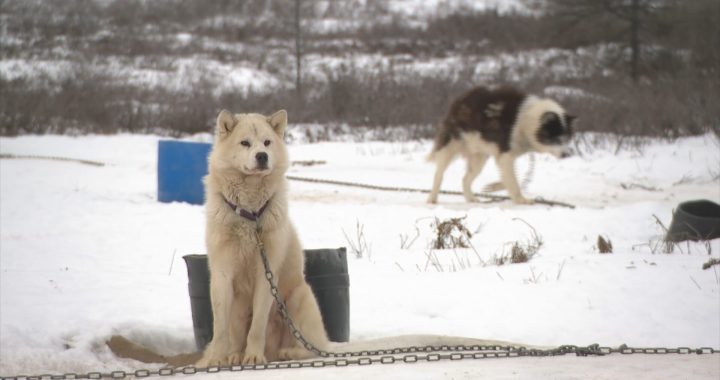Brittney Bessette says she’s finding out firsthand that finding childcare in Yellowknife is a daunting task.
“I pick childcare over rent sometimes,” she told APTN News. “Even with subsidy it’s really hard. Being a single mom and also finding the childcare that suits her needs and my needs is one of the biggest difficulties. But also one of the biggest pushes to be like, ‘okay, well, I know what kind of center I want to open.’”
Bessette is set to graduate in June from the two-year early learning and childcare diploma program at Aurora College in Yellowknife.
Until then, she’s finishing up her third placement of the year and fulfilling hands-on assignments, including leading playgroups that highlight northern Indigenous culture.
“I really enjoy it because [it’s] my culture too and being able to reconnect with it,” Bessette said. “It’s like, ‘oh, they’re actually learning,’ and they want to learn, and they want to be able to see what it’s like.”
Bessette has already been working in her field as an early childhood educator during summer breaks. With her five-year plan in place, she is aiming to find employment with a school district to build up her savings and ultimately open a center.
However, at present, there is a sense of unpredictability in the industry.
The territorial government struck a $51-million agreement with Ottawa in 2021 to lower childcare expenses to $10 a day by 2026 and create 300 additional spots.
But with more than 500 names on the Yellowknife Daycare Association waitlist alone, that target still leaves families in limbo.
A number of mothers shared with APTN that they are delaying their return to work after their maternity leave ends because they do not have access to childcare.
Aurora College program instructor and expectant mother, Anthoula Zachou, said the sector requires more support.
“We really need more spots for infants and toddlers. This is not enough for a whole city of 20,000-plus people,” Zachou said. “Having only two or three daycares with not even two spots in total and some home daycares.”
According to her, the program readies students for the job market and empowers them to demand fair compensation.
“I think that we just need more awareness on that, more research, more people to advocate for us,” Zachou said. “We play a crucial role in a child’s growth and development, and we just need better circumstances around us to be able to work.”
According to the latest data in the N.W.T., as of March 31, 2023, there were 1,932 licensed childcare spaces available in the territory. The spaces are filled in 40 family homes, 36 centers, and 31 out-of-school programs across the territory.
It can be just as tough to find childcare outside the capital city. Many remote communities lack daycare-appropriate buildings.
The territorial government reports that 14 out of the 33 communities in the territories lack licensed early learning and childcare programs.
In April 2023, Housing NWT and the Department of Education, Culture and Employment (ECE) launched a two-year pilot project to adjust rules, enabling renters in public housing to make modifications and receive financial assistance for retrofitting homes.
The trouble is there’s been zero interest.
Shelley Kapraelian, director of early learning and childcare system transformation, said there are several reasons why people choose to remain unlicensed.
“We don’t have a registration requirement for someone who’s unlicensed, but when we become aware of them, our regional early childhood consultants will reach out, and share information around the funding that they would benefit from,” Kapraelian said.
The territorial subsidy structure has been subject to criticism from licensed providers for its inadequate response to inflation and its restrictive policy of allowing fee increases of only two to six percent, depending on the total fee rates.
Childcare subsidies are only available for licensed day homes and centers. Kapraelian stated that the territorial government is enhancing training opportunities for day home providers and is also developing a retention incentive fund, along with the implementation of a wage grid by 2026.
“The way we’re talking about a wage grid is setting a minimum standard for educators that recognizes the hours and experience of work,” Kapraelian said. “It would be an hourly wage that they could expect at a minimum to receive.”
In the N.W.T., the average salary for ECEs working at a center is between $18 and $22 per hour.’ In the Yukon, ECEs make $30 according to the wage grid.
Many of the Aurora College students interviewed by APTN in 2022 have chosen to work as teacher’s assistants for a school board. In this role, they earn $35 per hour and have summers off.
That’s the route Jonathan Whitford plans to take. He’s a first-year ECE student who sees a big demand for educators in the north.
“There are more and more students who have exceptionalities, and it does make a little difficult, now instead of having one teacher for 25 kids, you have four teachers in a room,” Whitford said.
Whitford said that there is undoubtedly burnout in his field but all of his classmates who are currently in the program are there because they have a passion for working with kids.
While the territorial government promises to improve support for educators and expand childcare availability, Bessette maintains a positive outlook.
“Kids are always who I wanted to teach, molding their minds, and molding their futures. It’s what’s kept me there,” Bessette said.










